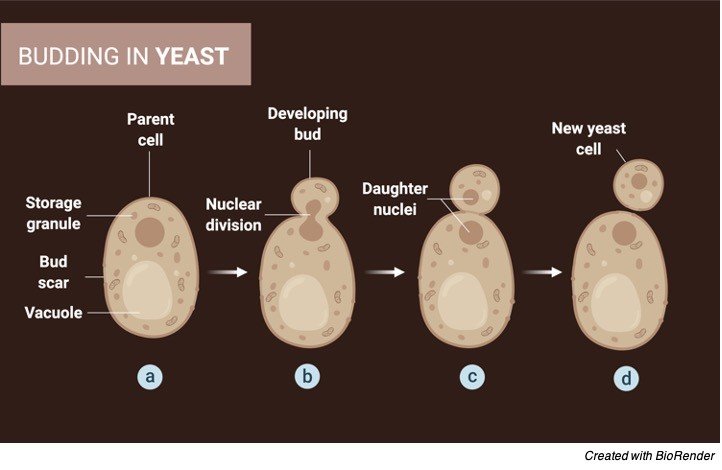Table of Contents
Asexual Reproduction Definition
A mode of reproduction in which the organism reproduces without mating and produces offspring by a single parent. It does not require the fusion of male and female gametes.
What is Asexual Reproduction?
The mode of reproduction where organisms produce offspring by the involvement of a single parent is called asexual reproduction.
In asexual reproduction, mating between male and female gametes is not necessary.
In asexual reproduction any organism can produce offspring in the absence of another parent, so the offspring produced by the asexual method resembles totally as its parent.
Asexual reproduction can be of different types like binary fission, fragmentation, sporogenesis, budding, parthenogenesis, and apomixis.
Asexual reproduction is a regular method of reproduction in microbes and primitive organisms; however, several plants, certain animals, fungi also reproduce by this method.
Reproduction is one of the crucial biological processes in which an organism produces biologically similar offspring. All organisms can reproduce in two significant modes- sexual and asexual.
Sexual Reproduction vs Asexual Reproduction
Asexual and sexual methods are major modes for reproduction adopted by most organisms. There are some differences between asexual and sexual reproduction which are listed below;
i. Asexual reproduction involves only one parent whereas sexual reproduction can only occur by the involvement of two parents which include paternal and maternal parents.
ii. In asexual reproduction, syngamy and meiosis are both processes that are not needed. Sexual reproduction cannot occur without syngamy.
iii. Meiosis is also present which is required to produce gametes. Asexual reproduction produces genetically identical off springs which are also termed clones of the parent, but in the case of sexual reproduction, off springs are not identical or different from their parents.
Advantages of Asexual Reproduction
The process of asexual reproduction is less complex and straightforward as compared to sexual reproduction. In this process, the organism produces offspring more quickly because of the participation of only one parent. Some courtship rituals seen in higher animals are also absent in organisms reproducing by asexual methods. Due to their quick reproducing ability, they can colonize fastly than higher animals.
Disadvantages of Asexual reproduction
Besides all the advantages, there are certain disadvantages also of this method. However, the method is less complicated and faster but apart from higher animals choose sexual reproduction commonly. Some higher animals which can reproduce asexually will only utilize it when sexual reproduction is not feasible.
According to researchers, 99.9% of eukaryotes reproduce by the sexual method. The major disadvantage of asexual reproduction is the lack of genetic diversity.
The organisms are a clone of its parent which leads to low genetic variation. In asexual reproduction, segregation during meiosis and crossing over is not present which is required for sexual reproduction.
These events are necessary for genetic variation, and therefore, their absence affects negatively evolutionary changes. Due to the same genetic material in all offspring, they may be similarly susceptible or resistant for a particular condition (e.g. viral disease) which increases the risk of getting wiped out by any disease.
The organisms which can reproduce only by asexual methods can get new genetic material through mutations.
Types of Asexual Reproduction
There are different types of asexual reproduction, like (1) binary fission (2) budding (3) vegetative propagation (4) spore formation (5) fragmentation (6) parthenogenesis (7) apomixis
i. Binary Fission
The process of dividing into two identical cells is called binary fission. Each of the cells can grow and reproduce also. Most prokaryotic organisms adopt binary fission to reproduce. Some archaea and protozoans also reproduce by this method.

There are three types of binary fission based on the manner of cell division, which is irregular type, longitudinal, and transverse- type. In irregular type, a cell divides along any plane. Longitudinal fission can be seen in Euglena and transverse-type is found in Paramecium.
ii. Budding
Budding is a type of asexual reproduction; in which an outgrowth is formed by an organism that developed into a new individual.

Certain bacteria and other asexual organisms reproduce by budding. For example- Hyphomicrobium, Stella spp. Saccharomyces cerevisiae, hydra.
iii. Vegetative Propagation
Vegetative propagation is most commonly used by plants to reproduce asexually. Several plants cannot produce seeds, which can be propagated by vegetative methods. In this method, a new plant develops from vegetative parts of the plant, like roots, stems, and leaves.
Vegetative propagation is also used by gardeners and horticulturists to conserve and propagate rare and important plant species. Vegetative propagation is categorized into two types- natural and artificial propagation.
Artificial propagation can be done by the means of tissue culture methods and root hormones, whereas natural means include bulbs, runners, corms, tubers, etc.
iv. Spore Formation
Some organisms produce asexual spores to produce asexually. The method is called sporogenesis. Sporogenesis is made up of two words, spore, meaning ‘seed’, and genesis, meaning ‘origin’. As the name indicates they can disperse as seeds. They have thick-walled and highly resistant structures which differ from true seeds. Some fungi and vascular plants use sporogenesis to reproduce.
v. Fragmentation
When the parent organism breaks into several fragments and each fragment develop into a new individual, this process is called fragmentation. Several fungi (e.g. yeasts), vascular and non-vascular plants, and animals reproduce by the method of fragmentation.
vi. Parthenogenesis
When the female organism produces offspring without fertilization, it is termed parthenogenesis. It is divided into two types- apomictic parthenogenesis and automictic parthenogenesis. In this reproduction method, several methods are adopted to restore ploidy, e.g. doubling the chromosomes, fusion of meiotic products.
Examples- aphids, rotifers, nematodes, lizards, birds, etc.
vii. Plant Apomixis
It is the method of reproduction in plants where a plant reproduces without fertilization. Some bryophytes give rise to sporophyte-looking offspring having ploidy of gametophyte, known as apogamy. Similarly when a gametophyte is produced from the sporophyte but having ploidy of a sporophyte, is termed as apomixis or apospory.
It is the common method of reproduction in plants. Apomixis can be of two types- gametophytic apomixis and sporophytic apomixis.
Asexual Reproduction Examples
a) Bacteria
Bacteria reproduce mainly by binary fission. In the first step, the DNA is replicated into two identical copies, then the cell is divided into two identical cells by the method of binary fission. In this process, the chromosomes segregate towards the opposite poles.
Later, the cellular content is also divided by the process of cytokinesis. Meiosis is absent in this process whereas mitosis occurs which does not involve spindle apparatus formation.
b) Slime Molds
Slime molds are fungal species that produce stalked fruiting bodies called sporangia. These sporangia contain spores. The spores are haploid, that are produced by the process of meiosis. In favorable conditions, these spores germinate and produce new individuals.
Plasmodium species are called slime molds that consist of both sexual and asexual phases in their life cycle. At unfavourable conditions, they are termed pseudoplasmodium. These spores can disperse by wind and germinate into an amoeba-like cell in favourable conditions.
c) New Mexico Whiptail Lizards
The scientific name of New Mexico whiptail lizards is Aspidoscelis neomexicanus. These species have only female organisms therefore they cannot reproduce by sexual mode. They adopt the method of parthenogenesis to reproduce asexually.
At first, they double their chromosome number into eight copies of each chromosome, therefore after two rounds of cell division, each daughter cell gets two sets of chromosomes. New Mexico whiptail lizards behave like facultative parthenogenetic, thus they do not produce identical offsprings and show genetic diversity.
Asexual Reproduction Citations
- Sexual and asexual reproduction in the colonial ascidian Botryllus schlosseri. Genesis . 2015 Jan;53(1):105-20.
- The roles of sexual and asexual reproduction in the origin and dissemination of strains causing fungal infectious disease outbreaks. Infect Genet Evol . 2015 Dec;36:199-209.
- Asexual reproduction: genetics and evolutionary aspects. Cell Mol Life Sci . 2007 Jun;64(11):1355-72.
Share












